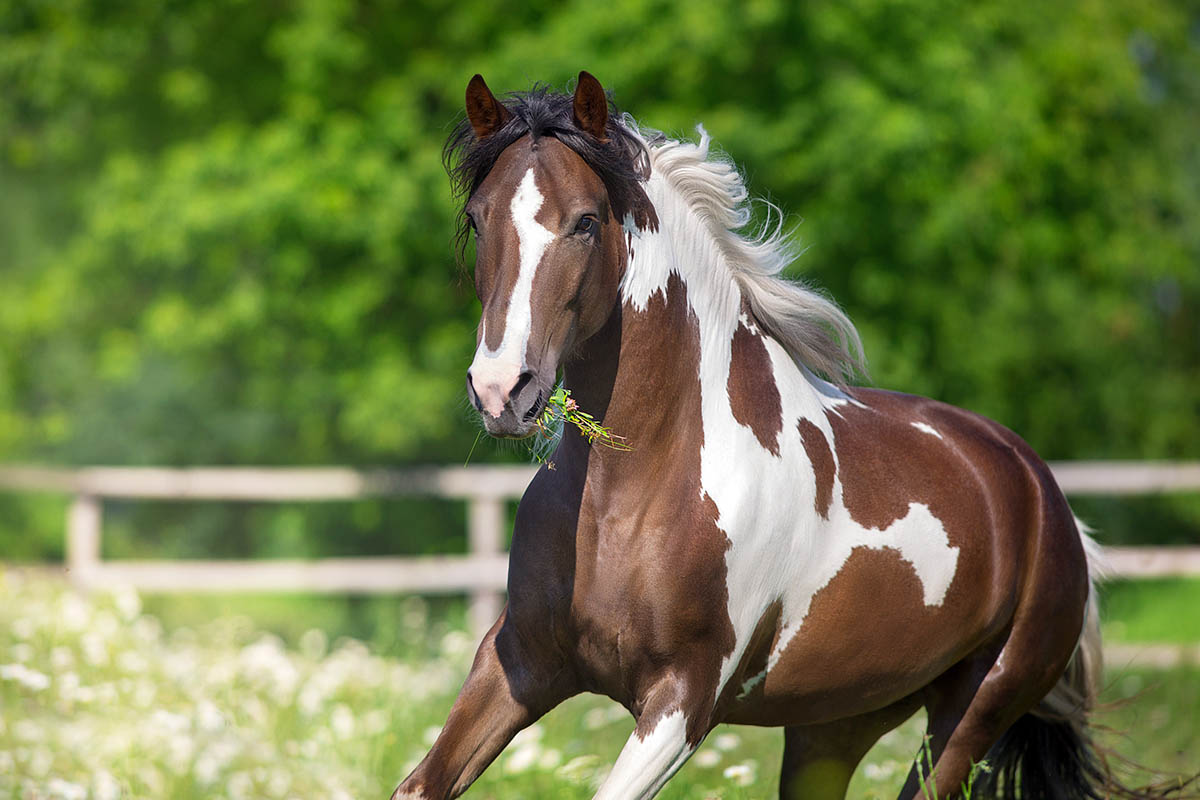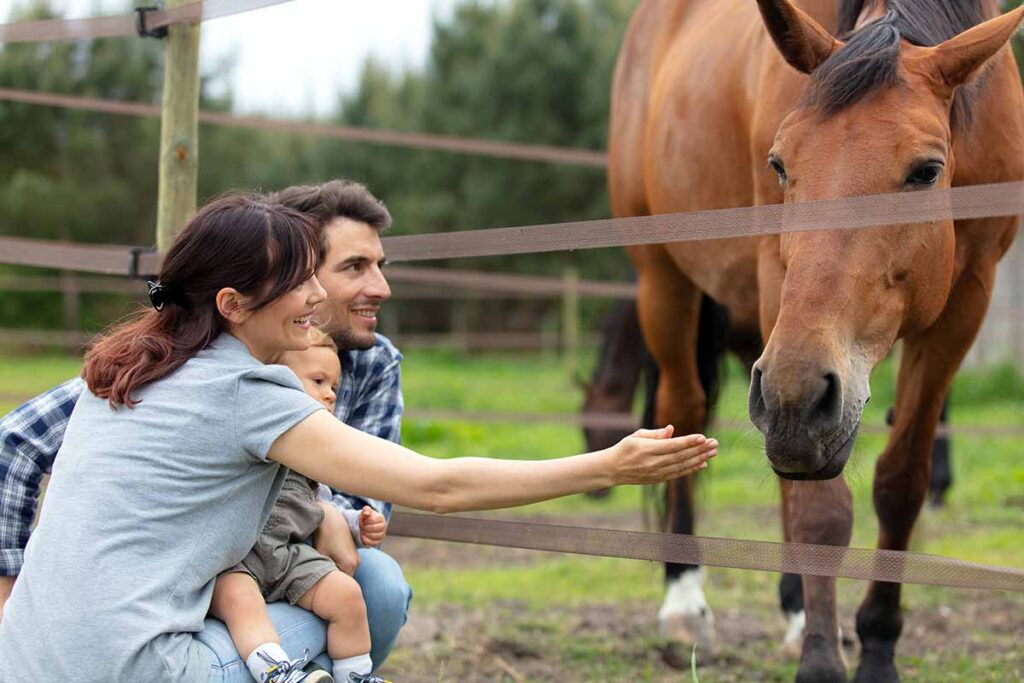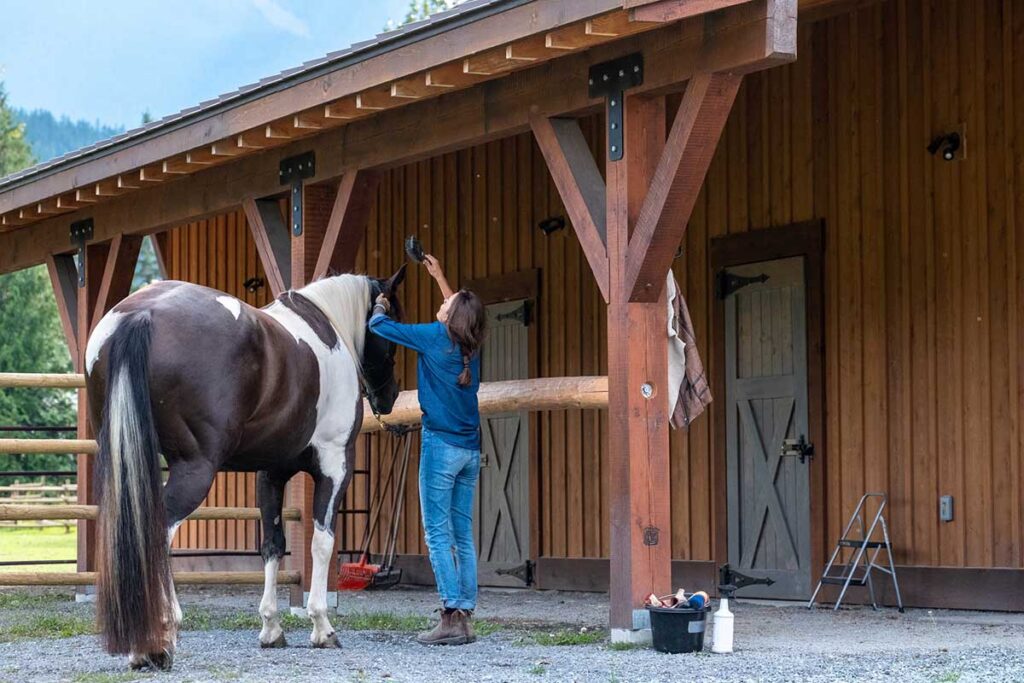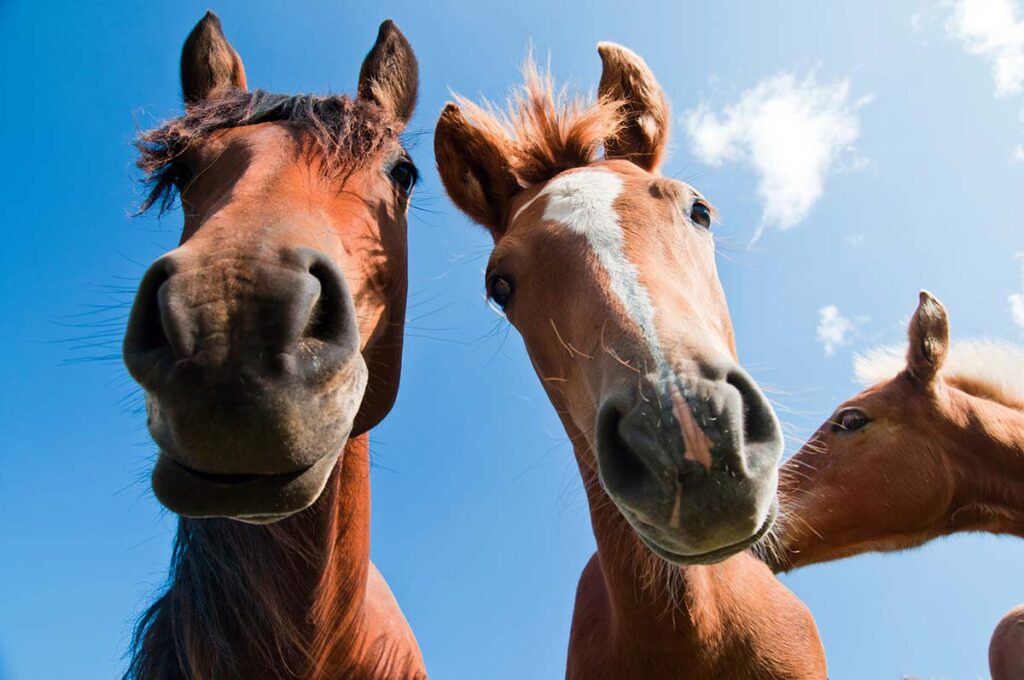Nothing lifts the spirits more than the promise of spring. Whether you’re emerging from a winter of snow and ice or a season of rain and mud, the day you notice buds on a tree or a robin on a fence line, you know that life around the barn is bound to get a bit easier. That doesn’t mean spring horse care isn’t without challenges. In fact, in some ways the season requires more vigilance than others to keep horses healthy and safe. From laminitis prevention to skin care to vaccinations, you’ll want to pay particular attention to certain horse-care areas as the weather warms. Here’s a rundown of spring horse care tasks and how best to complete them in the months ahead.
1. Review your horse’s vaccination needs.
The likelihood of exposure to various pathogens depends in part on a horse’s location and lifestyle. For instance, if you plan to take your horse to a show or clinic this year in a buggy climate, he might need a Potomac horse fever vaccination. Or, if you’ll be adding more group trail rides or events to your schedule, you’ll want to make sure your horse is protected against influenza and rhinopneumonitis.
Consider his herdmates, too. If they travel and then return to the farm, they can bring pathogens with them. Also, don’t assume older horses need fewer vaccinations. Research on this topic is still ongoing, but the notion that years of vaccination and exposure builds up stronger natural immunity to disease hasn’t been proven true. In fact, researchers might ultimately recommend more frequent vaccinations for older horses with health challenges.
Related Reading: Equine Vaccinations: What Your Horse Needs and When
2. Schedule immunizations early in the season.
It can take several weeks to complete the course of a new vaccination, and your horse’s immune system will need time to respond to even a single booster shot. To ensure he has maximal protection against diseases, count backward from when the disease vectors, such as flies or ticks, emerge in your area. The West Nile virus vaccine, for instance, is given as two shots four to six weeks apart to horses that have not received it before. Six weeks before insects emerge in your area, then, is the latest you’ll want to start that vaccination protocol.
3. Identify where mud is most likely to be a problem on your property and take action.

Most mud is a temporary nuisance, but sometimes soggy soil can threaten your horse’s well-being. Slick mud can lead to dangerous slips, for example, and deep “sucking” mud might pull off shoes and strain tendons. Mud mixed with manure and urine is more harmful to skin and hooves than “clean” mud that’s simply dirt and water.
To tackle mud problems in areas where horses gather on your property, you’ll need to redirect equine traffic. Consider moving water troughs, hay feeders, and even gates regularly to give parts of the field a “rest.”
Limiting turnout can lead to digestive and behavior problems, so that’s not a good solution. If you can’t relocate resources, consider putting down a layer of porous material, such as gravel, stone, or sand. This will encourage drainage while giving the horses a higher and drier surface to stand on. Longer-term solutions include re-grading portions of your pasture and/or installing geotextiles specifically designed to control mud.
4. Be on alert for abscesses.
Spring mud can contribute to the formation of painful hoof abscesses, particularly if a horse spends all day in a muddy paddock, then comes into a dry stall at night. The hoof capsule expands and contracts in response to these wet/dry cycles, leading to the development of small fissures in the hoof wall that allow bacteria to enter and become trapped.
An abscess in the hoof capsule will make a horse suddenly and dramatically lame in that limb. Your veterinarian or farrier might be able to pare down the hoof in the area around a pus pocket to relieve the pressure. But that won’t work if an abscess is deep within the foot. In that case, soak the hoof regularly to encourage the pus pocket to “burst” and drain. To reduce the risk of abscesses, keep your horse’s hooves as dry as possible. Mud management techniques can help, as can hoof pads, but a horse prone to abscesses might need to stay in a covered dry lot through the spring.
Related Reading: Everything You Need to Know About Horse Hoof Abscesses
5. Give your horse a bath.
A warm, soapy bath will not only wash away a winter’s worth of grime, but it will also allow you to give your horse a good once-over. As you scrub, pay particular attention to areas that are normally not brushed—between his jawbones, for instance, or the inside of the thighs. As you cleanse these areas, look for signs of skin irritation or infection and treat them if necessary. You can also use bath time to assess your horse’s body condition—do his ribs feel more prominent than before? What about his hip bones? This “hands on” assessment might reveal weight gain or loss that went unnoticed under winter blankets.
Watch: How To Bathe a Horse
6. Pay attention to your horse’s shedding.
The way a horse’s winter coat falls away can reveal important clues to his health. Most horses will “blow” their coats in two to three weeks. A horse that sheds more slowly, or not at all, might have pituitary pars intermedia dysfunction (PPID, also called Cushing’s disease), a potentially serious endocrine condition. If testing leads to a PPID diagnosis, starting the horse on the drug pergolide will help control the disease, and a full-body clip can make him comfortable. Also keep an eye on patchy shedders that lose different portions of their coat at different rates. For some this is normal. But, in addition to making horses look odd in the spring months, patchy shedding can be a sign of PPID.
Related Reading: How to Body Clip a Horse: Tips and Patterns
7. Groom often and thoroughly to keep your horse comfortable.
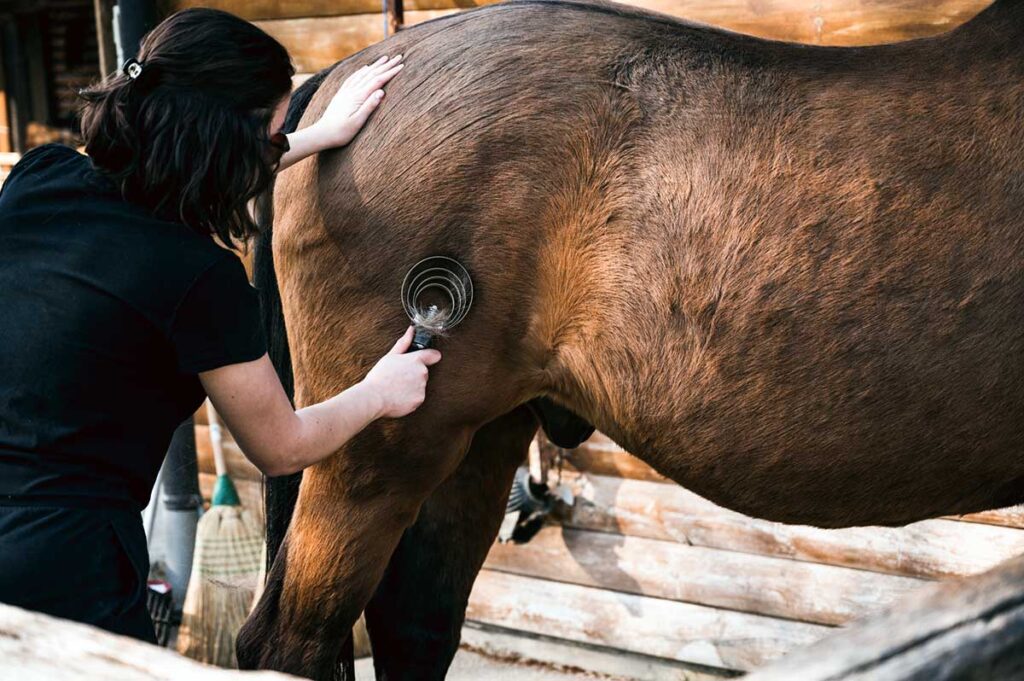
Elbow grease is the key to speeding up the shedding process. A vigorous session with a currycomb will pull winter coat hairs that are in the dormant phase from their follicles. Otherwise, the hairs would stay in place until the incoming summer coat pushed them out. Careful use of a shedding blade has the same effect, as does a fiberglass “slick block” or specialized shedding comb. Of course, you can also body clip a horse in the spring—keep in mind, though, he will still shed but the hairs will be shorter. And if there’s an early spring cold snap, you might also need to retrieve a winter blanket from storage to keep a newly clipped horse warm.
Watch: How To Groom Your Horse
8. Minimize insect exposure.
The seasonal return of winged pests can trigger skin allergies associated with their bites. Hypersensitivity to the saliva of tiny biting midges, also called sweet itch, is one of the more severe reactions. Any horse can be affected, but Icelandic Horses, Welsh Ponies, and Shires are most susceptible because of a genetic predisposition to the condition. The most obvious sign of the allergy is extreme itchiness, with the horse rubbing himself hairless and raw when seeking relief. Areas where the insects like to feed—the chest, midline, crest, and top of the tail—bear the brunt of the damage.
Researchers are working to develop a vaccine to reduce insect bite hypersensitivity, but currently management is the only defense against it. Keeping susceptible horses inside during periods of peak insect activity—primarily dawn and dusk—helps protect them, as does outfitting them in fly-proof garments, including sheets with belly bands, boots, and masks with ear nets. Look for garments specifically made for horses with sweet itch. If the horse is kept in a stall, fine-net screens over windows and doors can keep pests out.
In the barn, stall fans will help because midges are generally weak flyers that cannot overcome anything beyond a slight breeze. However, if management isn’t enough to prevent sweet itch, consult with your veterinarian about medications, such as topical steroids, that may help ease your horse’s discomfort.
Related Reading: Tips for Minimizing Flies on Your Horses and Property
9. Look out for rain rot.
As the weather warms, some horses become prone to the skin condition known as rain rot. The bacteria that causes it normally resides on the skin without problem but multiplies on damp, dirty, and sweaty coats. Rainrot causes tight, painful scabs to form along a horse’s topline and in runoff patterns along the flanks and hindquarters. Do not pick the scabs, and be careful if you clip the coat—both can be very painful to the horse. Instead, give your horse a few baths with a medicated, antimicrobial shampoo.
As his winter coat sheds and the new coat emerges, the rain rot will likely clear up quickly. Elderly horses or those with compromised immune systems may have more trouble fighting off the infection. In those cases, your veterinarian might suggest stronger treatments or medications.
10. Treat scratches promptly.
Standing in muddy paddocks or run-in sheds can lead to a case of scratches, or chapping and infection of the skin at the back of the fetlocks. The painful, oozing scabs form in the folds of skin and might be hidden under hair, but your horse will confirm their presence by protesting if you try to pick at the area. Treating scratches is simple: Wash the area with mild soap and dry it thoroughly—using a hair dryer if necessary—then lather the skin with a heavy-duty emollient, such as a diaper-rash cream, to act as a barrier against further moisture. Repeat this process every few days or daily if the weather is very wet, and the affected skin will heal on its own. Giving the horse a dry place to stand during the day will help.
Related Reading: Navigating 4 Common Horse Skin Issues
11. Assess your horse’s condition.
After being cooped up inside during winter, you’re probably eager to get back in the saddle, but you’ll need to proceed carefully to avoid injuring your horse. Before you ramp up your spring riding schedule, make sure your horse’s hooves are properly trimmed and/or shod, and map out some realistic goals.
An exercise program is key: Continual turnout is great for a horse’s overall health but will not appreciably improve his cardiovascular conditioning. Also, check to see whether his tack still fits: A less-active horse might have gained weight or lost muscle over the winter months, changing his contours.
Related Reading: On the Move: The Importance of Regular Exercise for Horses
12. Set realistic riding goals.
It will take at least a month of regular riding—a minimum of five days a week—to get a horse into moderate shape for significant trail riding. Older horses and those that have been completely inactive over the winter might require more time to regain their fitness. Budget enough time before planned events, then stick faithfully to the schedule to bring your horse back into shape.
13. Increase exercise intensity incrementally.
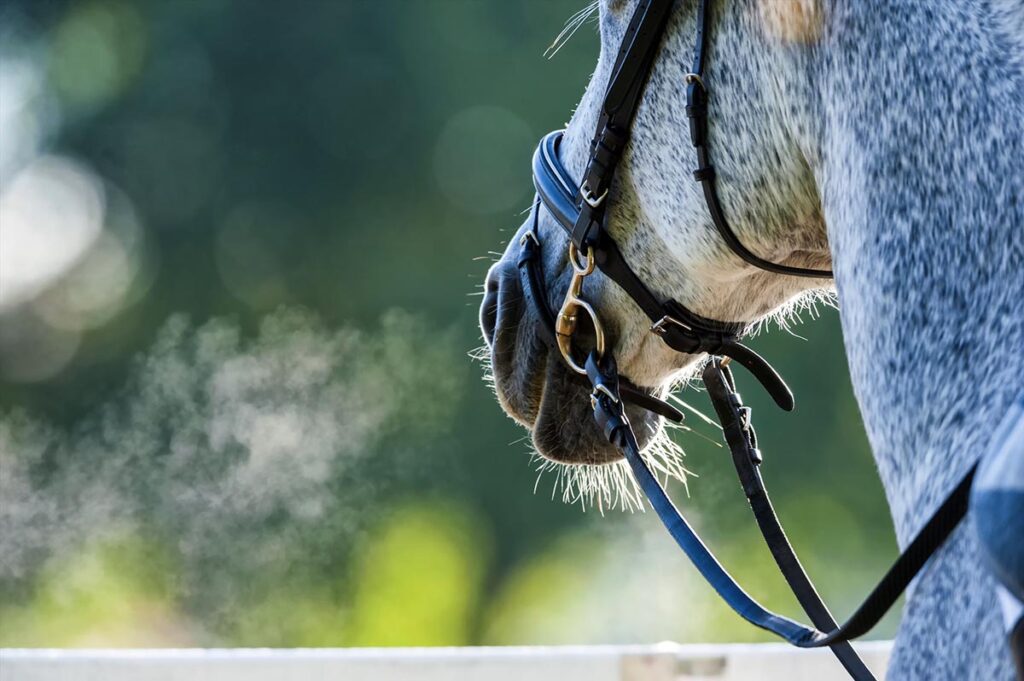
As a general rule, it’s best to do long, slow workouts for a few weeks before you start faster, skill-specific rides. Brisk walks, particularly up hills, are great for getting a horse back into shape. You need to stress your horse slightly to improve his fitness, but if you push too hard you’ll risk injury.
A good way to determine how he’s doing is to watch his breathing when you stop work: If it doesn’t return to normal within two minutes you’ve done too much. Learning to take your horse’s pulse will also help you monitor his fitness level. After a workout, a horse’s heart rate will typically return to normal (36 to 44 beats per minute) within 15 minutes. If his pulse is still elevated after 45 minutes, then the workout was too much for him and you’ll need to scale back.
Remember conditioning includes the musculoskeletal system as well as the cardiovascular system. Even if a horse isn’t huffing and puffing, his tendons and ligaments might be stressed. Stiffness or soreness after a ride or the next day indicate you’ve pushed him too hard.
Related Reading: How To Take Horse Vital Signs and What They Mean
14. Increase speed or distance but never both in a riding session.
Keep a log of your rides to make sure you follow this key tenet of conditioning. So, once your horse is coping well with 30-minute walks, add in a few minutes of trotting, but don’t extend the total length of your ride. Once he’s handling the trotting sessions well, then you can increase your ride times to 40 minutes. And on from there.
Take-Home Message
This season brings a fresh set of spring horse care considerations for owners. The transition from winter to spring is more than a shift in weather, however. It’s an opportunity to reassess and adjust our management strategies to ensure our horses are healthy, happy, and ready to enjoy the season to its fullest.
This article originally appeared in EQUUS.
Are you enjoying this content? Sign up for My New Horse’s FREE newsletter to get the latest horse owner info and fun facts delivered straight to your inbox!

